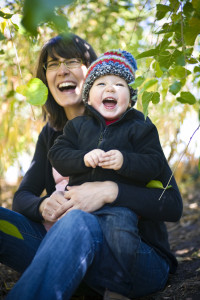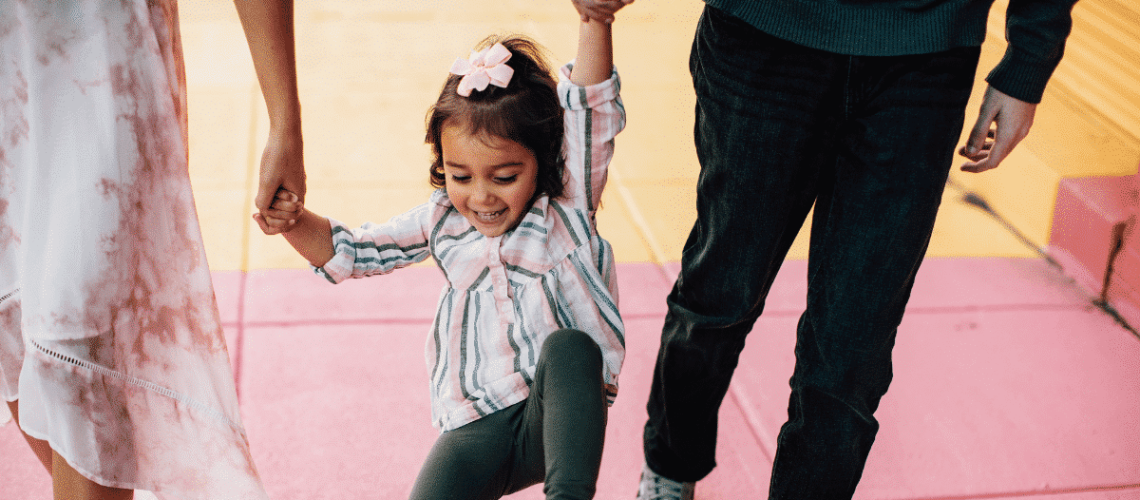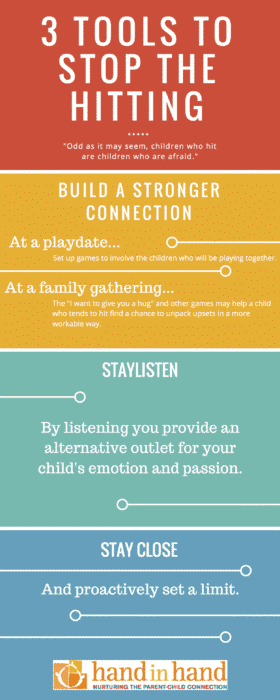Odd as it may seem, a child hitting means that child is afraid.
To help them stop hitting, it's helpful to understand that the fears that cause trouble for a child who hits usually have their roots in some frightening experience earlier in life, even though they may not seem frightened at all.
To manage the fear, the frightened child develops aggressive behavior that flares any time they feel tense. Instead of crying or saying they feel scared when fears are triggered, they tighten up, can’t ask for help, and lash out.
You don’t need to know why a child is fearful, in order to help them.
What’s needed are measures to increase a child's sense of safety and connection with you, whether you are a parent, caregiver, or a loving relative or friend.
You also need to take proactive steps to prevent them from landing any impulsive swats.
As you connect and protect, a child will begin to share with you the passionate feelings that drive their impulse to hit. Listening to a child’s feelings, while preventing them from hurting anyone, allows a child to release the underlying fear, so they can relax and see others as their friends, rather than as a threat.
If you are feeling overwhelmed by your child's aggression, you might want to begin with our detailed online video class, Helping Your Child with Aggression.
First, build a stronger connection
 Set up opportunities to connect more often, and more fully.
Set up opportunities to connect more often, and more fully.
Special Time is a tool that’s ideal for building connection. If it’s your own child, try to do a short Special Time very early in the day, perhaps upon waking, so that your child begins the day with your offer to do whatever they they want to do for the first five or ten minutes of the day.
During Special Time, pay warm, affectionate attention. This helps a child see that they are important to you, even if there are other siblings, a morning schedule and early phone calls you have to attend to. It puts first things first in the family.
If the child is someone you know outside your family, try Special Time or Playlistening when you first see them.
Take the less powerful role
On a playdate, you might set up some roughhousing or hide and seek games to involve the children who will be playing together. Add yourself to the mix, get down on the floor, and play with affection.
See if you can get laughter going by taking the less powerful role. Get the children working together to “get” you with pillows or balloons or by jumping out of nowhere to “scare” you during hide and seek. When there’s laughter (without tickling) and they are “winning,” you’re Playlistening. The laughter and sense of safety and power in Playlistening helps children bond with each other and releases tension. It helps them get a sense that they are safe, treasured, and secure in your presence.
At a family gathering, you might organize a tag game or an “I want to give you a hug” game that the children can win. You might, for instance, open your arms to try to give them big bear hugs. But stumble, fall, and fail. They will love getting the best of you. Nuzzle them now and then, but be sure not to be a very competent hugger. Make eye contact while you play. Be bamboozled by them, but keep bouncing back to try again. This kind of play is sheer heaven for children.
Sometimes a child might hit during playtime…
The child who tends to hit may, during such a playtime, find a chance to unpack their upsets in a more workable way.
They might bang an elbow, or find a defect in the cracker you offer, or look you in the eye and then start to use a crayon on your wall.
When you approach the child gently to bring a limit, they have a reason to cry and perspire or tantrum.
This expression of emotion is the beginning of the healing process for the feelings that they carry, most likely, the same feelings that sometimes cause them to hit.
For more on understanding children's emotions, download this guide.
Next, when a child cries, Staylisten
This means staying close, not taking the ensuing emotional storm personally, and letting the child know that you’re there for them.
You pour in support; they pour out their fear and upset. Often, a child goes quickly from “My cracker is broken, I need a new cracker!” to “I need my Mommy!” and from complaint to sheer panic.
Listen. No need to try to fix anything. You are just the right person to listen to them. Let them feel that panic about having bumped their elbow, about needing a whole cracker, or about any other urgent need of the moment. There will be time later for a band-aid, or to consider the cracker again.
For now, let them show you how upset they are. If they are missing Mommy or Daddy, let them know that they will always come back. Reassure them that you’ll watch over them and keep them safe.
A child's outpouring of emotion brings them deep relief
Feelings will pour out with great passion and force. Although it looks like dire things are happening, this outpouring is actually a deep relief for a child’s emotional mind.
The passion you see is what drives the impulsive behavior.
A genuine internal healing is occurring. All the child needs is your warmth, eye contact and a few words about the fact that they are safe with you.
When the storm has passed, the child will feel safer with you than ever before, whether they are your own child or a child in your care.
If building the connection doesn’t quickly result in a big cry about some small thing, then you’ll need to stay close to your impulsive hitter.
Watch for signs of increasing tightness. Children often (but not always) give you signals that their negative feelings are bubbling up.
- Their voices become edgy.
- Their faces lose mobility and sometimes lose color as well.
- They begin to try to control situations.
When you see this, move closer.
Don’t try to prevent hitting with words like, “OK, let’s take turns here. There’s no need to get upset.”
The upset is already inside of the child.
Once a child has signaled that they are in trouble, there are no words that can make that trouble disappear. What you can do is to make sure that their impulsive behavior hurts no one.
For more, read “When Your Child Hits You: A New Perspective”
Proactively set a limit
For instance, you might try hooking your arm around the frequent hitter’s midsection, and gently nudging them a step away from the other children. You are not forbidding any further play, simply ensuring safety. Say something like, “I need to put my arm here, Charlie. You can play, but I am going to come with you and keep my arm here for a while, so everyone stays safe.”
Your sense of calm and your gentle touch will probably help a child notice the tension that’s rising in them. They won’t want you there. They might squirm and try to push you away. Stand your ground. “I’m going to keep you safe. I know you want to play, and you can. I will go with you where you go.”
They may fume, and work their way into a good cry.
Your limit is helpful. You noticed trouble coming, and intervened in the kindest possible way
Proactive intervention saves a frightened child from feeling ashamed because their impulse overcame them and hurt someone again.
You are preventing another child from being victimized which is the responsible thing to do as a parent or guardian of the play environment.
No one is shamed, or isolated, but also, you haven’t let their impulses victimize another child. When the child finally bursts into tears, Staylisten.
Reassure them that they are a good friend. That other children are glad to play with them. That they will have a good day today, even though things feel hard right now. Let them know that they are safe with you, and you are glad to be with them.
Using this process, we have seen children's impulsive behavior melt into sensitivity and empathy for the feelings of other children
This process can be used again and again, to help a child who carries a knot of fear big enough to require several rounds of proactive limits and emotional release.
With repeated chances to play with an attentive adult, and then have good, passionate cries and tantrums in the circle of a kind adult’s arms, we have seen children’s whole personalities change over time. Their frequently impulsive behavior can melt into sensitivity and empathy for the feelings of other children.
Isn’t this what we all could use?
Someone to move in when we are edgy so we don’t splash our upsets on others, and then to listen to us vent our upsets in safety?
Someone kind enough to listen until the storm is over and we feel good about our lives again?
Children who tend to hit give us a chance to learn this kind of effective intervention—intervention to build a stronger friendship. Intervention that prevents corrosive behavior through listening, so a child can feel safe in their world again.
Here's how it can work:
In watching an interaction between siblings, I saw that the big sister was like a moth to her baby brother’s flame. She couldn’t stay away from him, but was impulsive the moment she got close.
The mom was exhausted and frustrated.
So I showed the mother how to put her hand on her daughter’s tummy as she approached the baby.
I encouraged her to say, “I know you want to kiss your brother. You can do that in a little while. Let’s just watch him and see what he likes, for now.”
No need to be unfriendly. No need to instruct. The mother was both ensuring the baby’s safety, and telling her daughter, “You love Billy. I can tell. You are such a sweet big sister.”
With the feel of that limit, the daughter immediately went into a vigorous tantrum, jumping up and down and writhing in her mother’s arms.
She tried frantically to reach for her baby brother. We told her we saw that she loved him, but said that she could kiss him and touch him a little later, not right now.
Big sister’s tantrum and sweaty struggle went on for fifteen or twenty minutes. We stayed positive, listened, and cared as her feelings poured out in her mommy’s arms.
When the daughter finally had worked her feelings through and didn’t feel frantic any longer, she looked at her Mommy, made sweet eye contact, and began to play with her Mommy’s buttons. She laughed a bit, and seemed relaxed.
We asked her if she wanted to kiss her brother now, and she did, gently, and then went off to play.
The mother’s limit and Staylistening had freed her of that compulsion to be near the baby and besiege him with sugar-coated aggression.
The mother was pleased, and now knew how to set a limit soon enough to help her daughter when her behavior became impulsive.
For more help with any kind of tantrums or upset, get our Tantrums and Indignation guide free when you sign up for our weekly newsletter, here.
You'll find a lot more specific ideas on how to end aggressive behavior in our online video class, Helping Your Child with Aggression.
Listen to a chapter of Patty's Wipfler's book Listen: Five Simple Tools to Meet Your Everyday Parenting Challenges here.



